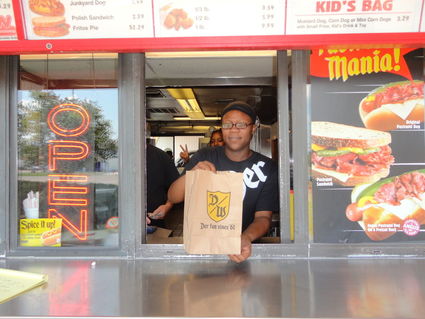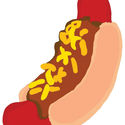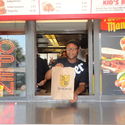For the love of hot dogs
Last updated 7/3/2013 at Noon
No matter what you call it, frankfurter, wienie, wiener, hot shot, frank or just a hot dog, Americans have loved them for many years and they remain of a staple for backyard barbecues and ballparks everywhere.
Across the U.S. as people celebrate the Fourth of July holiday, more than 150 million hot dogs will be eaten.
Locally, at the Wienerschnitzel in Orange, 21 employees served about 31,000 hot dogs in the month of June. However, according to Robert Littlefair, owner, June is typically a slow month and in December sales rise about 20 percent.
Wienerschnitzel has been at their current location in Orange since October 1969. They are currently operated by the Littlefair family.
Customers are often seen in a line of vehicles which extends out of the parking lot and along MacArthur Drive waiting for the chance to place their order. According to Sarah Littlefair, manager at Wienerschnitzel, the most popular choice of toppings is chili and cheese.
Here a wiener, they’re a wiener winner
Thousands of people will be flocking to Coney Island for the annual fourth of July event of the Nathan’s Hot Dog Eating Contest where 20 fans will devour hot dogs in minutes. Joey Chestnut, 28, of San Jose California, won his sixth straight hot dog-eating contest in 2012, when he ate 68 dogs and buns within 10 minutes. For his efforts he took home $10,000 and a mustard yellow belt.
But, they are not the only people who have demonstrated their love of hot dogs for all the world to see. Hot dogs were the first food eaten on the moon. Apollo 11 astronauts Neil Armstrong and Buzz Aldrin Jr. ate hot dogs on their 1969 journey.
Maximizing hot dogs
Hot dogs have been around a long time. Claims about hot dog invention are difficult to pinpoint, but legend has it the creation of the sausage with the placing on the bun has evolved into the beloved hot dog.
The word frankfurter comes from Frankfurt, Germany, where pork sausages similar to hot dogs originated. These sausages, Frankfurter Würstchen, were known since the 13th century and given to the people on the event of imperial coronations, starting with the coronation of Maximilian II, Holy Roman Emperor as King.
Wiener refers to Vienna, Austria, whose German name is “Wien”, home to a sausage made of a mixture of pork and beef Johann Georg Lahner, a late eighteenth century butcher from the Franconian city of Coburg, is said to have brought the Frankfurter Würstchen to Vienna, where he added beef to the mixture and simply called it Frankfurter. Nowadays, in German speaking countries, except Austria, hot dog sausages are called Wiener or Wiener Würstchen, meaning little sausage.
Around 1870, on Coney Island, German immigrant Charles Feltman began selling sausages in rolls.
Others have claimed to invent the hot dog and bun too. The idea of a hot dog on a bun is credited to the wife of a German immigrant, Antonoine Feuchtwanger, who sold hot dogs on the streets of St. Louis, Missouri in 1880. The bun was made so customers could eat their hot dogs without burning their hands.
Another claim of inventing the hot dog is told by Harry M. Stevens, an American sports concessionaire whose vendors sold German sausages and rolls to spectators at the old New York Polo Grounds during the winter. He called them “Dachshund sandwiches,” but a New York Post cartoonist couldn’t spell dachshund, so when he drew the cartoon, he called them hot dogs.
Size does matter
The length of the average hot dog is about seven inches. Although, it is common to go up to a foot long for those with a bigger appetite or for simply the love of hot dogs.
The longest hot dog measured 668 feet 7.62 inches and was made in Paraguay at the Expoferia in July 2011. The hot dog and bun were entirely edible. Following the successful record attempt, the hot dog was cut into 2000 portions and distributed to the public. The hot dog was created to commemorate Paraguay’s 200th anniversary as a country, according to the Guiness Book of World Records.
Hot dogs are now made by hundreds of companies all across the globe, and each company has its own secret recipe. In general, hot dogs contain meat such as beef, pork or chicken, meat fat, a cereal filler such as bread crumbs, oatmeal or flour, a little egg white, and spices such as onion, garlic, salt and pepper. However, there are also added perservatives, coloring and sodium nitrate that can be found in store-bought hot dogs.
The ingredients are blended together in a meat grinder or a food processor, and then stuffed into sausage casings. Most of the hot dogs from nearby stores are stuffed into synthetic collagen casings. Most of time, the famous snap when biting into a hot dog is long gone and can only be accomplished when using natural casings.
Some like it hot
Hot dogs may be served plain, but are commonly served with a variety of condiments, including ketchup, mustard, chile con carne, pickle relish, sauerkraut, onion, mayonnaise, lettuce, tomato, cheese, and chili peppers.
In 2005, the US-based National Hot Dog & Sausage Council found mustard to be the most popular condiment, with 32 percent of respondents preferring it; 23 percent of Americans said they preferred ketchup; chili con carne came in third at 17 percent, followed by relish at 9 percent and onions at 7 percent. Southerners showed the strongest preference for chili, while Midwesterners showed the greatest affinity for ketchup.
Condiments vary across the country. All-beef Chicago-style hot dogs are topped with mustard, fresh tomatoes, onions, sport peppers, bright green relish, dill pickles, and celery salt, but they exclude the popular ketchup.
Many variations are named after regions other than the one in which they are popular. Italian hot dogs which are popular in New Jersey include peppers, onions, and potatoes. Meaty Michigan hot dogs are popular in upstate New York, while beefy Coney Island hot dogs are popular in Michigan. In New York City, conventional hot dogs are available on Coney Island, as are bagel dogs. Hot wieners, or weenies, are a staple in Rhode Island where they are sold at restaurants.
Texas hot dogs are spicy variants like those found in upstate New York and Pennsylvania. A favorite in New Jersey is “all the way dog.”
Take me out to the ballpark
The association between hot dogs and baseball began as early as 1893 with Chris von der Ahe, a German immigrant. who owned not only the St. Louis Browns, but also an amusement park.
Some baseball parks have signature hot dogs, such as Fenway Franks at Fenway Park in Boston and Dodger Dogs at Dodger Stadium in Los Angeles. Dodger Stadium is hot dog heaven, selling the most hot dogs per year out of any ballpark in the country. In 2005, they sold more than 1.6 million hot dogs during their games.
The Fenway signature is a hot dog which is boiled and grilled Fenway-style, and then served on a New England-style bun, covered with ketchup and relish. Often during Red Sox games, vendors traverse the stadium selling the hot dogs plain, giving customers the choice of adding the condiments.
But, hot dogs are not only for those watching a ball game. Babe Ruth is said to have eaten 12 hot dogs and drink eight bottles of soda between games of a double header. He was later reportedly rushed to the hospital after the game with a severe case of indigestion.
Caring for your wiener

Mary Baker, an employee at Wienerschnitzel in Orange, serves one of their delicious hot dogs. In the month of June, more than 31,000 hot dogs were sold at the business.
There are also several variations on how to cook hot dogs. There is boiling, grilling, frying, steaming, microwaving and baking. They are even roasted over an open fire on the end of stick.
It is suggested to not puncture the hot dog when cooking it since the juices will run out which can result in a tough and dry hot dog. Hot dogs are a good item to freeze for up to 3 months. With most standard cooking methods, the hot dogs can go straight from the freezer to the pot or grill.
At the end of the day and the hot dogs have put a smile on everyone’s face, store unopened packages in the refrigerator and consume by the manufacturer’s use-by-date. Opened packages may be stored in a sealed plastic bag in the refrigerator and used within three days of opening, according to Kraft foods.
Mary Baker, an employee at Wienerschnitzel in Orange, serves one of their delicious hot dogs. In the month of June, more than 31,000 hot dogs were sold at the business. RECORD PHOTO: Debby Schamber
















Reader Comments(0)